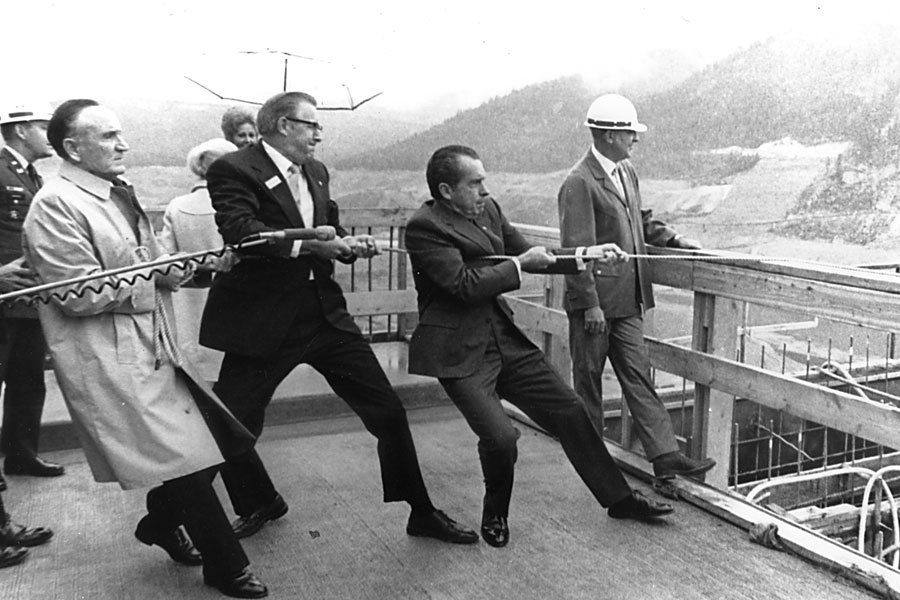When Air Force One touches down in Missoula on Thursday, it will mark President Donald Trump’s third visit to Montana in less than four months. The trip — a campaign stop to rally support for State Auditor Matt Rosendale’s run against U.S. Sen. Jon Tester — also means Trump will have tied Harry S. Truman for the most visits by a sitting U.S. president to Montana.
Sitting presidents have been making the journey to Montana for more than a century, and some have ventured to Northwest Montana.
Chester A. Arthur briefly entered the Montana Territory in 1883 during a tour of Yellowstone National Park. Twenty years later, by which time Montana had become a state, Theodore Roosevelt visited Butte, Helena and Gardiner. Roosevelt would go on to make two more visits to Montana in 1911 and 1918 after he left the White House.
Theodore Roosevelt’s distant cousin, Franklin D. Roosevelt, became the first sitting president to visit Northwest Montana when he took a tour of Glacier National Park in 1934. Roosevelt was on a tour of the West and arrived in West Glacier by train on Aug. 5. There, the president boarded Glacier Park Transport Company Cadillac No. 155 and took a ride over the newly constructed Going-to-the-Sun Road. At Many Glacier, the presidential party stopped for lunch before continuing on to Two Medicine, where Roosevelt addressed the nation via radio.
“Today, for the first time in my life, I have seen Glacier Park,” the president told the nation. “Perhaps I can best express to you my thrill and delight by saying that I wish every American, old and young, could have been with me today. The great mountains, the glaciers, the lakes and trees make me long to stay here for all the rest of the summer.”
“There is nothing so American as our national parks,” Roosevelt continued. “The scenery and wildlife are native. The fundamental idea behind the parks is native. It is, in brief, that the country belongs to the people.”
Truman visited Montana in 1948, 1950 and 1952. The final visit included a swing through Northwest Montana to dedicate the Hungry Horse Dam and campaign for Democratic candidates, dueling objectives that he combined into one speech at the dam on Oct. 1, 1952. At the time, U.S. Rep. Mike Mansfield was running for Senate and Adlai Stevenson was running to replace Truman as president. Mansfield went on to win his race a month later but Stevenson was trounced by Republican Dwight D. Eisenhower.
“This dam was built by the people of the United States, acting through their government to service the economy, the industry, and the people of this Northwestern region. It will promote the welfare and security, and increase the prosperity of the entire United States,” Truman said. “Now I want to give you a little advice. All of you who are here today have better go over and take another good look at that dam, because if the Republicans win this election, it will be a long time before you see another new structure of that kind.”
Afterwards, Truman visited Flathead High School in Kalispell where he spoke to a large crowd about how the newly completed Hungry Horse Dam would beckon new industry, including the Columbia Falls Aluminum Company plant that opened in 1955. Truman then boarded a private rail car and headed west, making brief campaign stops in Whitefish, Eureka, Libby and Troy.
Richard Nixon was the next sitting president to visit Northwest Montana. In 1971, Nixon was bound for Alaska for an historic meeting with the Emperor of Japan, when he stopped in Kalispell. Nearly 22,000 people greeted the president at Glacier Park International Airport, where Nixon was presented with freshly caught Montana trout. Joining Nixon was Mansfield, who by then was Senate majority leader. Nixon, a Republican, noted that while he had disagreements with his Democratic counterpart, they frequently met with each other and on occasion found common ground.
“We sometimes disagree, disagree not as partisans, but disagree because there are areas where different people, working toward the same goal, might want to take different roads,” the president said. “But I think you will all be glad to know that there is one subject on which we have no disagreement whatever. That is on the beauty of the Big Sky Country.”
Nixon then boarded a military helicopter bound for Libby where he inspected the Libby Dam, which was still under construction, and even helped pour some concrete.
Four years later, President Gerald Ford spoke of the importance of energy independence and protecting the environment at a dedication for the Libby Dam.
“All of you know better than I that Montana is one of our most rugged and untouched areas,” Ford said. “It stands as a symbol of our natural resources and our native spirit. Libby Dam is also a symbol of how a commitment to the environment can be balanced with our technological needs.”
During the ceremony in Libby that attracted 4,000 spectators, Ford joined Canadian Minister of Energy, Mines and Resources Donald S. MacDonald in throwing a ceremonial switch sending energy from the Libby Dam into the power grid.
Ford is the last sitting president to have ventured to Northwest Montana, but one vice president and one former president have come to the Flathead. In 1997, Vice President Al Gore visited Glacier National Park — and hiked to Grinnell Glacier — to raise awareness about climate change. And in the spring of 2008, former President Bill Clinton spoke to more than 2,800 people at Flathead Valley Community College during Hillary Clinton’s prolonged primary battle with then-Sen. Barack Obama. That same spring, both candidates made stops in Missoula.
